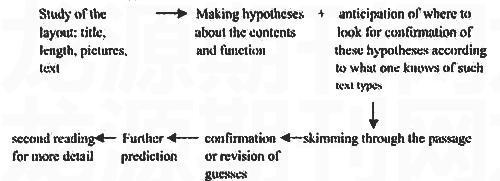Discourse Analysis and the Teaching of English Reading
2009-03-25成青苗
成青苗

Abstract:This paper is first to discuss the nature of reading and then enumerate some typical errors in students' English reading, and finally propose some advice on the teaching of English reading from the angle of discourse analysis.
Keywords:discourse analysis English reading
1 What is reading
Reading is an essential skill for English as a foreign language(EFL) student. It is an active skill which constantly involves guessing, predicting, and checking and asking oneself questions. Meaning does not reside on the printed page, nor is only in the head of the reader, but is extracted by combining the words on the printed page with the readers' background knowledge and experiences.
Understanding the process of reading has been the focus of much research. Models have been proposed by these researchers. They can be divided into three categories: bottom-up models, top-down models and interactive models. Bottom-up or data-driven models depend primarily on the information. Segal Owitz, Poulsen & Komoda (1991) indicated that these lower-level processes consist of word recognition and include visual recognitions of letter features, letter identification, generation of grapheme-phoneme correspondences, utilization of orthographic redundancies such as regularities in letter sequences, the association of words to the semantic representations, possibly the identification of basic syntactic structures within the portion of text currently being read, and with the generation of propositional units(p.17). As for top-down models, Segal Owitz, Poulsen & Komoda (1991) point out that this higher level is concerned primarily with integration of textual information and includes resolving ambiguities in the text, linking words with their co-referents, integrating propositional units across sentences, generating and updating a schema or representation of the text as a whole, and integrating textual information with prior knowledge(P.17). Interactive models which combine elements of both bottom-up and top-down models are currently accepted as the most comprehensive description of the reading process. Stanovich states that in interactive models "process at any level can compensate for deficiencies at any other level Higher processes can actually compensate for deficiencies in low-level processes."(Stanovich,1980,p36) Grabe(1991) emphasizes two conceptions of interactive approaches. The first relates to the interaction that occurs between the reader and the text. This suggests that meaning does not simply reside in the text itself but that as readers interact with text their own background knowledge facilitates the task of comprehending. The second conception of interactive approaches relates to the interaction between bottom-up and top-down processes.(p378)
2 Some typical errors in reading comprehension
2.1 Lexical errors
Words such as "imaginative" and "imaginary" and "respectable" are often misunderstood and misused by Chinese learners as in their mother tongue words have virtually no inflexions. In my classroom, however, I have found students more liable to stumble over articles and prepositions. I believe the reason is that these particles are never used in the Chinese language and hence difficult to handle.
2.2 Meaning "between the lines"
And moreover, Chinese readers often get lost while reading paragraphs with implied meanings or meanings "between the lines". Suppose the students are asked to read the following paragraph:
"If you are interested in buying a pair of contact lenses, be prepared to pay $200 or more. Generally there are three main reasons why people want contact lenses. You may need them because the cornea of your eye is misshapen and ordinary glasses are not satisfactory. If so, you'll be in the group that comprises 1 to 2 per cent of contact lens wearers. But you may want them for a sport, avocation, or vocation. Perhaps you're a baseball player, a boxer, a swimmer, an aviator, an actor, or perhaps you're engaged in an industry where flying particles may endanger your eyes. If you get your contact lenses for one of these reasons, you are in the same group with about 20 per cent of the users. But if for some reasons, you feel that glasses are handicapping our appearance and you would rather have invisible glasses, you'll have lots of company. About 79 per cent of lens users hope to improve their looks."
The students are then asked to make a decision; which of the following can represent the writer's intention? A or B.
A.To give the reasons for people wearing contact lenses.
B.To say that man is sometimes vain.
In accordance with my experiences, many readers will prefer A because they can easily find enough evidence to support that decision. If we take the paragraph into further consideration however, we find that they have failed to notice the rational relationship between the users, that is, the writer never fails to mention the percentage of users when giving each reason. The majority of wearers seem to feel that contact lenses are more attractive than glasses. Although the writer purposely establishes his contextual relationship within the paragraph, it may still be difficult for the students to work out what he really means to transfer.
2.3 Anaphoric expressions
Anaphoric expression is another pitfall for Chinese students in their reading comprehension. According to Gui Shichun (1991), reference, substitution, ellipsis and lexical cohesion are often talked about under that topic of anaphora in Halliday's and Hasan's writings. By reference and substitution the author means the fact that a writer refers back or forward to a word, a fact, a sentence or whatever has been mentioned somewhere else in the text. Besides pronouns, almost all other parts of speech can be used as reference words. Usually these words follow closely the parts they refer to, but sometimes they appear far from the mentioned parts. Students should be able to identify the coreference, and, if necessary, they should be asked to search the adjacent text until they find the required referents.
2.4 Non -linguistic information
Reading needs both visual and non-visual information. If a reader lacks non-visual information (what he has already known about the reading text, about the language, and about the world in general), his interpretation of the visual information will be severely limited, because what he can see is his brain's interpretation of the brain"(Smith, 1973). This is an interaction between thought and graphic designs. Therefore, in order to decode those graphic designs, a reader must be equipped with both the knowledge of language and of the world.
Shall I compare thee to a summer's day?
Thou art more lovely and more temperate (Shakespeare)
To a Chinese student's knowledge, spring is a pleasant season while summer is usually associated with unbearable heat. But in England, summer is mild and comfortable. Obviously some geographical knowledge should be introduced here.
3 The application of discourse analysis in the teaching of English reading
Discourse analysis which has an ancient origin has long been the interests of many scholars and language teachers. And in last few decades, various theories has been emerged through research. More or less they emphasize the functions of a language forms and regard discourse as a kind of social activity by social members. Scholars in this area have attached much importance to the meaning of a discourse and its context, cultural background knowledge and relationship between language elements and also that of different levels of structure, etc. .The development of discourse analysis creates many hints to language teaching. The text approach of teaching English reading has been one of them. It has been adopted by many language teachers as an efficient way to eliminate some typical errors in reading comprehension. It can be illustrated in the following way:

When put this approach into practice, the following points should not be overlooked
3.1Enlarge students' prior background
knowledge
As de Beaugrande(1980:30) notes,the question of how people know what is going on in a text is a special case of the question of how people know what is going on in the world at all." The interpretation of discourse is based to a large extent on a simple principle of analogy with what we have experienced in the past. What's more, it is probably safe to say that the prior knowledge determines your accurateness of your expectation of a text. Tannen's (1980) experiment proved that different cultural backgrounds can result in different schemata for the description of witnessed events. Thus it becomes essential to introduce customs, geographical features, ideologies etc. to students.
3.2 Get students familiar with different genres of English
"Genres refers to the staged purposeful social processes through which a culture is realized in a language."(Matin & Rothery, 1986:243) linguists considered genres as types of goal-directed communicative events. They include poems, narratives, expositions, lectures, seminars, recipes, broadcasts and so on. Being familiar with these different genres and their layout and functions can speed up the readers' making out of the topic and grasping of the meaning of a text.
3.3Use the mechanism of cohesion to facilitate the guess of meaning
Notions such as anaphora, anaphora etc. in the theory of cohesion give us many hints in the teaching of English reading. Here I'd like to take anaphora as an example. "Halliday & Hasan hold that cohesion relationships within a text are set upwhere the INTERPRETATION of some elements in the discourse is dependent on that of another. The one PRESOPPSES the other in the sense that it cannot be effectively decoded except by resource to it.' (1976:4) The following paradigm example is to show such a cohesive relationship.(1976:2)
Wash and core six cooking apples. Put them into a fireproof dish
Of the text they say:"It is clear that them in the second sentence refers back to the six cooking apples in the first sentence" (1976:2) Thus if we cannot make out the anaphoric functions of them, the meaning of the sentence cannot be extracted smoothly. So one of the tasks we language teachers should do in our daily teaching is to get students familiar with these mechanism of cohesion.
The relationships between sentences sometimes can compensate the loss of meaning of a text. That is to say, we can work out the meaning of a difficult sentence by considering its relationship with other understood sentences. So it becomes essential to equip students knowledge of judging the relationships between sentences. Here I'd like to mention Halliday & Hasan's taxonomy of types of explicit markers of conjunctive relations. It is exemplified as:a.additive: and, or, furthermore, similarly, in additionb.adversative: but, however, on the other hand, neverthelessc.causal: so, consequently, for this reason, it follows from thisd.temporal: then, after that, an hour later, finally, at last.
Besides these explicit markers, to train student reading skills of undermining the underlying semantic relation is much more difficult and significant challenge for language teachers.
3.4 Use context strategy in determining the meaning of a word
The meaning of a word is changing through the time. And there are many quite different sometimes even unrelated shades of the meaning of a word. Thus it can never be determined literally. According to the view point of modern linguists, the meaning of a word to a large extent is determined by its context of a text. Halliday divide context into a linguistic and non-linguistic one. And linguistic context consists of context of situation and context of culture. Thus when teaching students English reading, we should consciously train students' the reading skill of determining the meaning of a word by examining carefully the different context of the word.4 Conclusion
The area of integrating the theories of discourse analysis with the English teaching is far from completed. We language teachers are responsible to play the role as a bridge between discourse analysis and English teaching and more hints will thus emerge from the research of discourse analysis by language teachers.
References:
[1]de Beaugrande, R.1980. Text, Discourse and Process London: Longman.
[2]Gillian Brown & George Yule, 1983.DiscourseAnalysis London: Cambridge University Press.
[3]Halliday, M. A. K.& Hasan, R.1976. Cohesion in English London: Longman.
